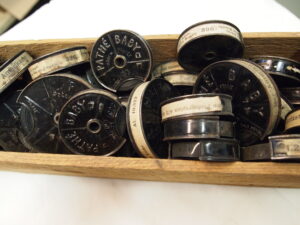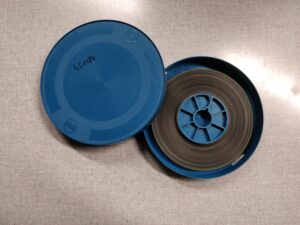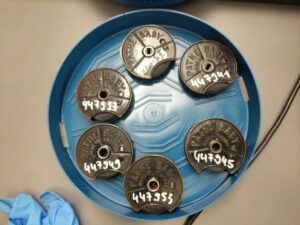Processing a 9.5 movie collection
The Kinemathek Lichtspiel received the collection Kohler-Carrard in the year 2021. At the same time, Isabelle Hasler, student at Bern Academy of the Arts, started her internship at the Lichtspiel. Her main task was to examine and catalog this collection.
The collection of the family includes some written documents about the handling of a photo camera, a 9.5mm film camera, some directories of purchased films as well as amateur films on 9.5mm b&w and 16mm b&w and color. Because of its diversity, this collection is a perfect example of how we work with 9.5mm film at Lichtspiel. In the following we describe the handling of the 9.5mm amateur films and purchase films. We have different approaches for the two genres.
Amateur film is rolled out from the original reel or cassettes and visioned. This is the only way to describe in detail the content and plot of the film. Several short amateur films are rolled together onto a 16mm core and separated with a short leader. However, each film is cataloged individually in the database and described in detail in terms of content as well as form (format, material, condition, etc.). Approximately 120 meters of film are rolled onto one core. Once all the films have been cataloged, the core is placed in a 16mm film can. Before the can goes into cold storage, the AD value is measured and the entire database entry is checked by another person.
The process is slightly different for the library films. We don’t remove them from their original cassette. Each cassette is labeled with the inventory number. Cataloging is done with the help of the book “The 9.5mm Vintage Film Encyclopaedia” (Pedler, Wyatt, Moules, 2020). This book provides information about title and year of release of the library films. In addition, the online source “Filmathèque – Pathé-Baby” (1931, http://archive.org/details/filmatheque00path) was used. The “Filmathèque – Pathé-Baby” is a directory with almost all library films, which were produced by Pathé on 9.5mm. The directory is divided into different categories such as nature or cities and, unlike the “Encyclopaedia”, contains a description of the content of the film. This content has been included in the database. Several cataloged cassettes are placed together in a 16mm film can (120 or 240 meters). Here, too, the AD value is measured and the database entry is checked by another person.
We want to use the symposium “9.5mm: And Cinema Is Everywhere” in November to also discuss problems and issues of processing 9.5mm film and are looking forward to input.


